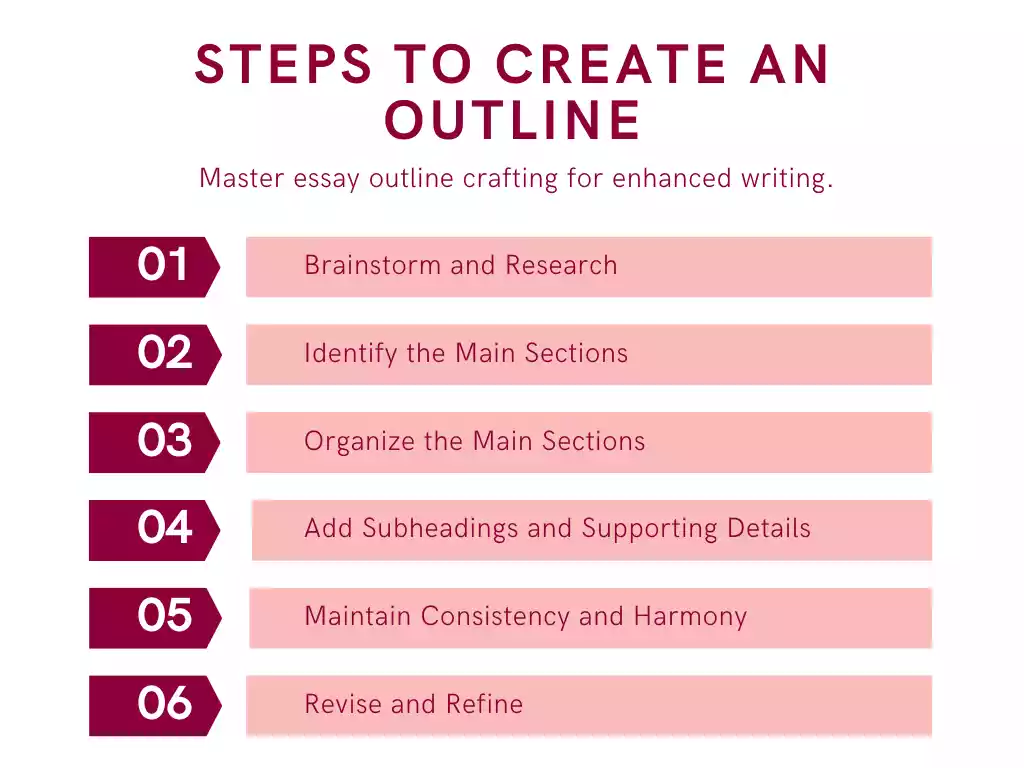How to Write an Outline for an Essay (With an Example)
Writing an essay can be a daunting task, but having a well-structured outline can make the process much more manageable and efficient.

An outline serves as a roadmap for your essay, guiding you through the main ideas and supporting details.
In this article, we will explore the step-by-step process of creating an outline for an essay, along with helpful tips and examples.
Table of Contents
Understanding the Purpose of an Outline
Before diving into the process, it’s essential to understand the purpose of an outline. An outline helps you organize your thoughts, maintain focus, and ensure a logical flow of ideas.
It serves as a foundation for your essay, allowing you to see the overall structure and coherence of your arguments before you start writing. You get it!
Steps to Create an Outline
Step 1: Brainstorm and Research
Before creating an outline, spend some time brainstorming ideas and conducting research on your essay topic.
Gather relevant information, jot down key points, and identify the main arguments or themes that you want to address in your essay.
Step 2: Identify the Main Sections
Once you have a clear understanding of your topic, identify the main sections or headings that will form the backbone of your essay.
These main sections will become the primary divisions of your outline.
Step 3: Organize the Main Sections
Next, organize the main sections in a logical order that flows naturally from one idea to another.
Consider the most effective sequence to present your arguments or information, ensuring a coherent and smooth progression throughout your essay.
Step 4: Add Subheadings and Supporting Details
Under each main section, add subheadings and supporting details that expand on the main ideas.
These subheadings and supporting details provide structure and depth to your outline, ensuring that each section is well-supported and comprehensive.
Step 5: Maintain Consistency and Harmony
Carefully review your outline to ensure it maintains consistency and harmony throughout.
Pay attention to the grammatical structure within each level of the outline, ensuring uniformity in the form of complete sentences for subheadings or starting each supporting detail with a verb.
This focus on consistency and harmony creates a sense of coherence and clarity in your outline, facilitating a smooth flow of ideas for both you and your readers.
Step 6: Revise and Refine
After creating the initial outline, take the time to revise and refine it. Make adjustments or additions to refine your outline further.
Ensure that the outline reflects the main ideas and supporting details you want to include in your essay.
Tips for Effective Outlining
To ensure your outline maximizes its benefits, keep the following tips in mind:
1. Keep it Simple and Concise
Keep your outline simple and concise, focusing on the main ideas and key supporting details. Avoid including excessive information or getting too detailed at this stage.
2. Use Parallel Structure
Maintain parallel structure throughout your outline. This means using consistent grammatical patterns for each level of the outline, such as using complete sentences for all subheadings or starting each supporting detail with a verb.
3. Maintain Logical Flow
Ensure a logical flow in your outline, allowing the reader to follow the progression of your ideas easily. Each section should lead naturally to the next, creating a coherent and cohesive structure.
4. Flexibility in Rearranging Ideas
Remember that an outline is a flexible tool. If you find that the order of your main headings or subheadings needs adjustment as you develop your essay, feel free to rearrange them accordingly.
Example Outline for an Essay
Here is an example outline for an essay about the benefits of exercise:
I. Introduction
A. Hook: The importance of maintaining a healthy lifestyle
B. Thesis statement: Regular exercise offers numerous benefits for physical and mental well-being
II. Physical Health Benefits of Exercise
A. Improved cardiovascular health
B. Weight management and increased metabolism
C. Strengthened immune system
III. Mental Health Benefits of Exercise
A. Reduction in stress and anxiety
B. Enhanced mood and emotional well-being
C. Improved cognitive function and memory
IV. Social Benefits of Exercise
A. Opportunities for social interaction and connection
B. Boost in self-confidence and self-esteem
V. Conclusion
A. Recap of the main benefits of exercise
B. Encouragement to incorporate regular exercise into daily life
Conclusion
Creating a well-structured outline is an important step in the essay writing process. It serves as a roadmap, guiding you through the main ideas and supporting details, ensuring a coherent and logical flow in your essay.
By following the steps outlined in this article, you can develop a detailed and effective outline that will make the writing process smoother and more organized.
Remember to brainstorm and research your topic, identify the main sections, organize them in a logical order, and add subheadings and supporting details.
Maintain consistency and harmony, and be open to revising and refining your outline as needed.
An effective outline keeps your essay focused, prevents you from going off-topic, and helps you maintain a clear and structured argument.
It saves time and ensures that your ideas are presented in a logical and coherent manner.
So, before you start writing your next essay, take the time to create a comprehensive outline.
It will be your guide and foundation, ensuring that your essay is well-organized, engaging, and effectively conveys your message to the reader.
FAQs
- Q: How long should an essay outline be? The length of an essay outline can vary depending on the complexity of the topic and the depth of your analysis. In general, an outline can range from a single page to multiple pages. Focus on including all the necessary headings and subheadings to effectively structure your essay.
- Q: Can I change my outline while writing the essay? Yes, it’s common for outlines to evolve as you delve deeper into your research and writing. You may discover new ideas or find that the initial organization needs adjustment. Be flexible and open to revising your outline to better suit the content and flow of your essay.
- Q: Should I include references in my outline? It’s not necessary to include references in your outline, as it is a condensed version of your essay’s structure. However, if you have specific sources or quotations you want to incorporate, you can note them briefly in the outline as a reminder for when you write the actual essay.
- Q: Can I have more than one level of subheadings in my outline? Yes, depending on the complexity of your essay, you may have multiple levels of subheadings. This can help you further organize your thoughts and provide a clear hierarchy of ideas within each section.
- Q: Is it possible to create an outline after writing the essay? While it’s generally recommended to create an outline before writing, it is possible to create one after you’ve completed your essay. In such cases, you would be summarizing and organizing the main points and arguments already present in your essay to create a structured outline.





